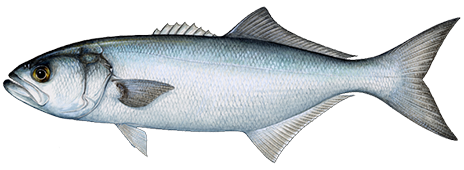Bluefish

Anglers can sniff out bluefish by their smell, which is something like fresh cucumbers.
HOW TO IDENTIFY A BLUEFISH
The bluefish is the only member of the family Pomatomidae. The mouth has extremely sharp teeth. The existence of a spine in the second dorsal fin, the absence of head markings, and the lack of an interspace between the dorsal fins distinguish the bluefish from the similar looking greater amberjack. The bluefish’s lack of finlets immediately distinguishes it from the mackerels. The voracious bluefish richly deserves the nicknames marine piranha and chopper because it swims in large schools through shoals of bait fish, slashing and destroying everything in its path. They will bite anything, including unlucky swimmers. Bluefish can easily inflict serious wounds even when the fish is out of water; as many a careless fishermen has learned.
WHERE TO CATCH BLUEFISH
The bluefish is found worldwide, including the Mediterranean and Black Seas, in temperate to tropical waters, although sporadic in occurrence and location. The following list includes additional details on where to catch this fish:
Blackflow Bays and Esturies
Birds Breakers
Channels Entrances Man-Made Structures
Merging Water Schools
HOW TO CATCH BLUEFISH
Fishing methods include trolling, chumming, casting, jigging, and live and dead bait fishing from boats, shores or piers. Live baits are preferred, but plugs, lures or feathers are also used. Bluefish does not keep well if frozen, and the flesh tends to become soft if not eaten soon after capture. The following are fishing methods used to catch this fish:
Jigging Drift Fishing
Trolling Surf Casting
Still Fishing
The following are lures, tackle or bait that can be used to catch this fish:
Jigs Plugs
Saltwater Live Bair Spinner Baits
Spoons Squid